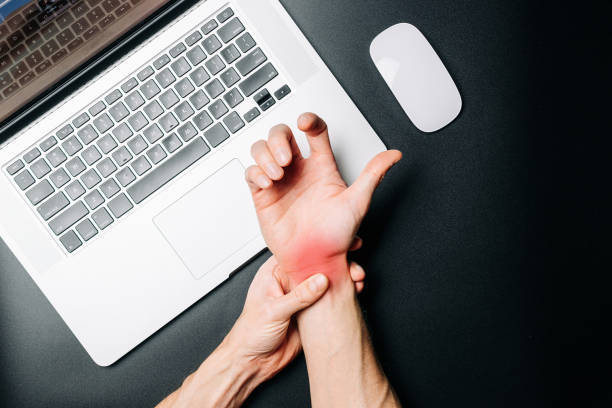Safe, Effective Relief Without Surgery or Downtime
Carpal Tunnel Syndrome (CTS) is one of the most common nerve compression conditions, affecting thousands of people every year—especially those who type, lift, grip, or perform repetitive hand motions. Symptoms such as wrist pain, numbness, tingling, and weakness can make everyday activities difficult and may worsen over time if left untreated.
The good news: most cases of carpal tunnel can be treated successfully with non-invasive, conservative therapies. At Spine Align Chiropractic & Wellness in Huntsville, we focus on restoring nerve function, reducing inflammation, and improving mobility—without injections or surgery.
Below are the most effective non-invasive treatment options available today.
1. Radial Shockwave Therapy (RSWT)
Targeted therapy for tissue healing and nerve irritation
Radial Shockwave Therapy is one of the most advanced, non-invasive treatments available for CTS. It uses pressure waves to stimulate the body’s natural healing response, increase circulation, and reduce inflammation around the median nerve.
Benefits of Shockwave Therapy for CTS:
-
Reduces inflammation in the wrist and carpal tunnel
-
Breaks up scar tissue and adhesions contributing to nerve compression
-
Promotes tissue regeneration
-
Improves mobility and grip strength
-
Safe, affordable, and no downtime
-
Effective for chronic or stubborn cases
RSWT is especially helpful when symptoms haven’t responded well to bracing alone or when patients want a treatment option before considering injections or surgery.
2. Chiropractic Adjustments for the Wrist, Elbow, and Cervical Spine
Improves nerve flow from the neck to the hand
Many patients are surprised to learn that carpal tunnel symptoms can also be influenced by tension or misalignment in the:
-
wrist bones
-
forearm
-
elbow
-
shoulder
-
cervical spine
Because the median nerve travels through all these regions, reduced mobility or joint compression anywhere along the pathway can worsen symptoms.
Chiropractic adjustments help restore movement, reduce joint irritation, and improve nerve communication.
Common areas adjusted for CTS:
-
Carpal bones of the wrist
-
Elbow joint
-
Shoulder/scapula
-
Cervical spine (especially C6–C7)
This approach is gentle, non-invasive, and often provides immediate relief.
3. Soft Tissue Therapy & Myofascial Release
Tension in the forearm can aggravate carpal tunnel symptoms
Tightness in the forearm flexor muscles is one of the most overlooked contributors to CTS. These muscles attach at the elbow and travel down to the wrist, and chronic tension increases pressure around the median nerve.
Soft tissue therapy can include:
-
Myofascial release
-
Trigger point therapy
These therapies reduce muscular tension, improve circulation, and relieve nerve irritation.
4. Wrist Bracing and Activity Modifications
Protects the wrist and reduces strain during healing
A neutral-position wrist brace helps keep the carpal tunnel open and reduces pressure on the median nerve, especially at night.
Activity modifications may include:
-
Adjusting keyboard height or wrist angle
-
Using ergonomic tools
-
Taking scheduled stretch breaks
-
Avoiding repetitive gripping when possible
These changes give inflamed tissues time to recover and prevent further irritation.
5. Therapeutic Exercises for Strengthening and Nerve Gliding
Restores function and reduces long-term recurrence
Specific home exercises help reduce inflammation, open the carpal tunnel, and increase median nerve mobility.
Common exercises include:
-
Nerve gliding (“median nerve flossing”)
-
Wrist flexor and extensor stretches
-
Grip strengthening
These exercises are simple, effective, and can be performed at home to maintain results.
7. Posture and Ergonomic Correction
Improves nerve flow from the neck to the hand
Poor posture—especially forward head posture from prolonged computer use—can irritate nerves in the neck that contribute to wrist symptoms.
Correcting ergonomics and improving posture reduces stress on the entire nerve pathway.
When to Seek Treatment
You should seek evaluation if you experience:
-
Numbness or tingling in the thumb, index, or middle finger
-
Wrist or forearm pain
-
Weak grip strength
-
Symptoms that wake you at night
-
Difficulty performing daily tasks
Early treatment leads to faster recovery and reduces the likelihood of needing injections or surgery.
Non-Invasive Help for Carpal Tunnel in Huntsville, AL
At Spine Align Chiropractic & Wellness, we specialize in conservative, non-surgical treatment options for carpal tunnel syndrome, including:
-
Radial shockwave therapy
-
Chiropractic adjustments
-
Soft tissue techniques
-
Home exercise plans
-
Ergonomic and posture correction
If you’re experiencing wrist pain, numbness, or tingling, we can create a personalized treatment plan based on your symptoms and daily activities.
Schedule an Appointment
If you're ready to find relief without injections or surgery, contact Spine Align Chiropractic & Wellness:
Huntsville, AL
(256) 881-1321
spinealignchiropractic.net









